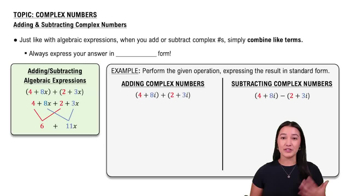Here are the essential concepts you must grasp in order to answer the question correctly.
Complex Numbers
Complex numbers are numbers that have a real part and an imaginary part, expressed in the form a + bi, where 'a' is the real part and 'b' is the coefficient of the imaginary unit 'i', which is defined as the square root of -1. Understanding complex numbers is essential for performing operations such as addition and subtraction.
Recommended video:
Addition and Subtraction of Complex Numbers
To add or subtract complex numbers, combine their real parts and their imaginary parts separately. For example, when adding (3 + 2i) and (5 - 7i), you would add 3 and 5 to get 8, and 2i and -7i to get -5i, resulting in the complex number 8 - 5i.
Recommended video:
Adding and Subtracting Complex Numbers
Standard Form of Complex Numbers
The standard form of a complex number is expressed as a + bi, where 'a' and 'b' are real numbers. This format is important for clarity and consistency in mathematical communication, allowing for easier interpretation and manipulation of complex numbers in various mathematical contexts.
Recommended video:
Complex Numbers In Polar Form
 Blitzer 3rd Edition
Blitzer 3rd Edition Ch. 5 - Complex Numbers, Polar Coordinates and Parametric Equations
Ch. 5 - Complex Numbers, Polar Coordinates and Parametric Equations Problem 3
Problem 3 Verified step by step guidance
Verified step by step guidance


